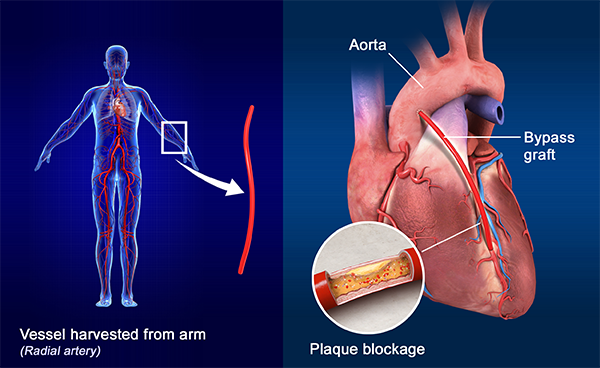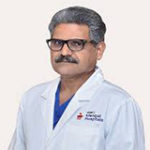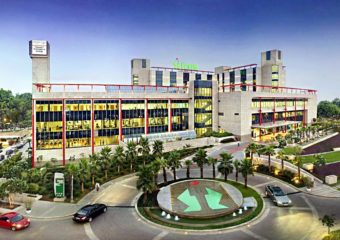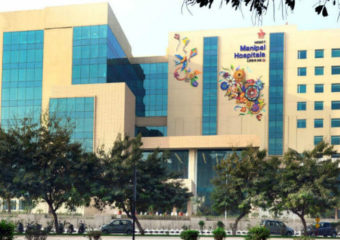Heart Bypass (CABG) Surgery Cost in India
The Heart Bypass (CABG) Surgery Cost in India ranges between USD 4000 to USD 5000.
Heart Bypass Surgery is better in response to stenting. It is usually the best go-to-option for a blocked LAD.
The survival rate for coronary bypass surgery patients who make it in the first few months is similar to that of the general population.
As delineated by an article in the Deccan Herald, India is among the top medical tourist destinations for cardiology, orthopaedics, transplants, and ophthalmology with a success rate close to 100%.

Overview
Coronary bypass surgery redirects blood around a section of a blocked or partially blocked artery in your heart. The procedure involves taking a healthy blood vessel from your leg, arm or chest and connecting it below and above the blocked arteries in your heart. With a new pathway, blood flow to the heart muscle improves.
Coronary bypass surgery doesn’t cure the heart disease that caused the blockages, such as atherosclerosis or coronary artery disease. However, it can ease symptoms, such as chest pain and shortness of breath. For some people, this procedure can improve heart function and reduce the risk of dying of heart disease.
Other Names for Coronary Artery Bypass Grafting
- Bypass surgery in India
- Coronary artery bypass surgery In India
- Heart bypass surgery In India
- CABG Surgery In India
Who needs a Cabg Surgery
Bypass is done for the following reasons:-
- Plaque: which is a component of blood builds up in the artery and blocks the way. This reduces the blood flow in the heart so the heart muscle is more likely to tire or fail. This causes failure in the left ventricle which is known as the main pump of the heart.
- Coronary artery disease or atherosclerosis – If the coronary arteries become narrow or constricts so there is an increased chance of fatal heart attack.
- When the blockage is too grave to be managed by medication (beta blockers) or other alternative treatments (balloon angioplasty).
- Severe CAD – This condition involves clogging of arteries by fatty deposition which reduces blood flow.
Why CABG Surgery done?
Coronary bypass surgery is one treatment option if you have a blocked artery to your heart.
You and your doctor might consider it if:
- You have severe chest pain caused by narrowing of several arteries that supply your heart muscle, leaving the muscle short of blood during even light exercise or at rest.
- You have more than one diseased coronary artery, and the heart’s main pumping chamber — the left ventricle — isn’t functioning well.
- Your left main coronary artery is severely narrowed or blocked. This artery supplies most of the blood to the left ventricle.
- You have an artery blockage that can’t be treated with a procedure that involves temporarily inserting and inflating a tiny balloon to widen the artery (angioplasty).
- You’ve had a previous angioplasty or placement of a small wire mesh tube (stent) to hold the artery open that hasn’t been successful. Or you’ve had a stent placement, but the artery has narrowed again.
- Coronary bypass surgery might also be performed in emergency situations, such as a heart attack, if you’re not responding to other treatments.
Even with coronary bypass surgery, you’ll need to make lifestyle changes after surgery. Medications are prescribed routinely after coronary bypass surgery to lower your blood cholesterol, reduce the risk of developing a blood clot and help your heart work as well as possible.
Types of CABG Surgery
Traditional Coronary Artery Bypass Grafting
This is the most common type of coronary artery bypass grafting (CABG). It’s used when at least one major artery needs to be bypassed.
During the surgery, the chest bone is opened to access the heart. Medicines are given to stop the heart, and a heart-lung bypass machine is used to keep blood and oxygen moving throughout the body during surgery. This allows the surgeon to operate on a still heart.
After surgery, blood flow to the heart is restored. Usually, the heart starts beating again on its own. In some cases, mild electric shocks are used to restart the heart.
Off-Pump Coronary Artery Bypass Grafting
This type of CABG is similar to traditional CABG because the chest bone is opened to access the heart. However, the heart isn’t stopped, and a heart-lung bypass machine isn’t used. Off-pump CABG is sometimes called beating heart bypass grafting.
Minimally Invasive Direct Coronary Artery Bypass Grafting
This surgery is similar to off-pump CABG. However, instead of a large incision (cut) to open the chest bone, several small incisions are made on the left side of the chest between the ribs.
This type of surgery mainly is used for bypassing the blood vessels in front of the heart. It’s a fairly new procedure that’s done less often than the other types of CABG.
This type of CABG isn’t for everybody, especially if more than one or two coronary arteries need to be bypassed.
Physical Exam and Diagnostic Tests
To determine if you’re a candidate for CABG, your doctor will do a physical exam that involves checking your cardiovascular system, focusing on heart, lungs and pulse. Your doctor also will ask you about any symptoms you have, such as chest pain or shortness of breath, and how long, how often and how severe they are.
- Complete blood count (CBC): A low blood count can warn your doctor to prepare for a blood transfusion in advance.
- Prothrombin time (PT) and thromboplastin time (PTT) values: These blood tests measure your blood’s bleeding and clotting time. These tests show altered values in presence of any bleeding or clotting disorders or if you’re on blood-thinning medications like aspirin.
- Chest X-ray: To assess the size and shape of your heart and aorta.
- Cardiac catheterization: This test is used to identify the location of blockages in your coronary arteries that will help your doctor in planning your surgery.
- Other tests, such as kidney and liver function tests to determine the health of these organs.
Before Procedure
- Your doctor will explain the procedure and you can ask questions.
- You will be asked to sign a consent form that gives your permission to do the test. Read the form carefully and ask questions if anything is unclear.
- Along with a review of your health history, your doctor may do a complete physical exam to make sure you are in otherwise good health before having the procedure. You may need blood tests or other diagnostic tests.
- You will be asked to not eat or drink for 8 hours before the procedure, generally after midnight.
- You may be asked to shower with a soap or special cleanser the night before and the morning of surgery.
- Tell your doctor if you are pregnant or think you could be.
- Tell your doctor if you are sensitive to or are allergic to any medicines, iodine, latex, tape, or anesthetic medicines (local and general).
- Tell your doctor about all medicines (prescription and over-the-counter), vitamins, herbs, and supplements that you are taking.
- Tell your doctor if you have a history of bleeding disorders or if you are taking any blood-thinning medicines, aspirin, or other medicines that affect blood clotting. You may be told to stop some of these medicines before the procedure.
- Your doctor may do blood tests before the procedure to find out how long it takes your blood to clot.
- Tell your doctor if you have a pacemaker or any other implanted cardiac device.
- If you smoke, stop smoking as soon as possible. This may improve your chances for a successful recovery from surgery and benefit your overall health.
- Based on your medical condition, your doctor may ask you to do other things to get ready.
During Procedure
Coronary artery bypass graft surgery (CABG) requires a stay in a hospital. Procedure may vary depending on your condition and your doctor’s practices.
Generally, CABG Surgery follows this process:
- You will be asked to remove any jewelry or other objects that may interfere with the procedure.
- You will change into a hospital gown and empty your bladder.
- A healthcare professional will insert an intravenous (IV) line in your arm or hand. Other catheters will be put in your neck and wrist to monitor your heart and blood pressure, as well as to take blood samples.
- You will lie on your back on an operating table.
- The anesthesiologist will continuously monitor your heart rate, blood pressure, breathing, and blood oxygen level during the surgery. Once you are sedated (put into a deep sleep), a breathing tube will be put into your throat and you will be connected to a ventilator, which will breathe for you during the surgery.
- A catheter will be put into your bladder to drain urine.
- The skin over the surgical site will be cleaned with an antiseptic solution.
- Once all the tubes and monitors are in place, your doctor will make incisions (cuts) in one or both of your legs or one of your wrists to access the blood vessel(s) to be used for the grafts. He or she will remove the vessel(s) and close those incision(s).
- The doctor will make an incision (cut) down the center of your chest from just below the Adam’s apple to just above the navel.
- The doctor will cut the sternum (breastbone) in half lengthwise. He or she will separate the halves of the breastbone and spread them apart to expose your heart.
Coronary artery bypass graft surgery-on-pump procedure
- To sew the grafts onto the very small coronary arteries, your doctor will need to stop your heart temporarily. Tubes will be put into the heart so that your blood can be pumped through your body by a heart-lung bypass machine.
- Once the blood has been diverted into the bypass machine for pumping, your doctor will stop the heart by injecting it with a cold solution.
- When the heart has been stopped, the doctor will do the bypass graft procedure by sewing one end of a section of vein over a tiny opening made in the aorta, and the other end over a tiny opening made in the coronary artery just below the blockage. If your doctor uses the internal mammary artery inside your chest as a bypass graft, the lower end of the artery will be cut from inside the chest and sewn over an opening made in the coronary artery below the blockage.
- You may need more than one bypass graft done, depending on how many blockages you have and where they are located. After all the grafts have been completed, the doctor will closely check them as blood runs through them to make sure they are working.
- Once the bypass grafts have been checked, the doctor will let the blood circulating through the bypass machine back into your heart and he or she will remove the tubes to the machine. Your heart may restart on its own, or a mild electric shock may be used to restart it.
- Your doctor may put temporary wires for pacing into your heart. These wires can be attached to a pacemaker and your heart can be paced, if needed, during the initial recovery period.
Coronary artery bypass surgery-off-pump procedure
- Once your doctor has opened the chest, he or she will stabilize the area around the artery to be bypassed with a special instrument.
- The rest of the heart will continue to function and pump blood through the body.
- The heart-lung bypass machine and the person who runs it may be kept on stand-by just in case the procedure need to be completed on bypass.
- The doctor will do the bypass graft procedure by sewing one end of a section of vein over a tiny opening made in the aorta, and the other end over a tiny opening made in the coronary artery just below the blockage.
- You may have more than one bypass graft done, depending on how many blockages you have and where they are located.
- Before the chest is closed, the doctor will closely examine the grafts to make sure they are working.
Recovery in the Hospital
- After surgery, you’ll typically spend 1 or 2 days in an intensive care unit (ICU). Your heart rate, blood pressure, and oxygen levels will be checked regularly during this time.
- An intravenous line (IV) will likely be inserted into a vein in your arm. Through the IV line, you may get medicines to control blood circulation and blood pressure. You also will likely have a tube in your bladder to drain urine and a tube to drain fluid from your chest.
- You may receive oxygen therapy (oxygen given through nasal prongs or a mask) and a temporary pacemaker while in the ICU. A pacemaker is a small device that’s placed in the chest or abdomen to help control abnormal heart rhythms.
- Your doctor may recommend that you wear compression stockings on your legs as well. These stockings are tight at the ankle and become looser as they go up the leg. This creates gentle pressure up the leg. The pressure keeps blood from pooling and clotting.
- While in the ICU, you’ll also have bandages on your chest incision (cut) and on the areas where an artery or vein was removed for grafting.
- After you leave the ICU, you’ll be moved to a less intensive care area of the hospital for 3 to 5 days before going home.
Recovery at Home
Your doctor will give you specific instructions for recovering at home, especially concerning:
- How to care for your healing incisions
- How to recognize signs of infection or other complications
- When to call the doctor right away
- When to make followup appointments
You also may get instructions on how to deal with common side effects from surgery. Side effects often go away within 4 to 6 weeks after surgery, but may include:
- Discomfort or itching from healing incisions
- Swelling of the area where an artery or vein was removed for grafting
- Muscle pain or tightness in the shoulders and upper back
- Fatigue (tiredness), mood swings, or depression
- Problems sleeping or loss of appetite
- Constipation
- Chest pain around the site of the chest bone incision (more frequent with traditional CABG)
Full recovery from traditional CABG may take 6 to 12 weeks or more. Less recovery time is needed for nontraditional CABG.
Your doctor will tell you when you can start physical activity again. It varies from person to person, but there are some typical time frames. Most people can resume sexual activity within about 4 weeks and driving after 3 to 8 weeks.
Returning to work after 6 weeks is common unless your job involves specific and demanding physical activity. Some people may need to find less physically demanding types of work or work a reduced schedule at first.
What are the side effects of Cabg surgery?
- Tiredness: This is quite common after a major operation. The body is busy doing the repairing process of the wound. Allow adequate rest for the body and mind. As the days progress, you will feel better.
- Reduced Appetite: There are several reasons for loss of appetite. Distaste caused by some of the medications is a common problem. Acidity caused by stress and some medicines is another reason.
- Pain: is the commonest problem. Remember there are safe pain killers which may be used regularly until pain in relieved fully. It is important to take regular pain medications in the first two weeks.
- Sleeplessness: Anxiety and pain are the villains. In the first few weeks you require adequate pain relief. As the health improves, your normal sleep habit will return.
- Swelling of legs: Mild or even moderate swelling of feet and legs are common after veins have been removed during CABG. This is not a disease. The deep vein system will take care of the blood circulation adequately. It takes some time for the body to make this adjustment. Simple methods like leg elevation and crepe bandages or elastic stocking can relieve this problem.
- Sore throat: The plastic tube which is kept in the windpipe during anesthesia and immediate post operative period can cause mild inflammation and pain in throat during first few days. Mild pain killers and warm saline gargles can take care of this.
- Numbness: One of the most common and consistent complaints after bypass operation is the pain and numbness in the left side of chest. Fine nerves along the Internal Mammary Artery (IMA) are cut while harvesting this artery for bypass. These are nerves that supply the front of chest. There may be numbness, burning pain, different feeling during touch or shooting pain. Usually Left IMA is taken. So the symptoms are on the left side of chest (may involve breast in women). If both IMA are used these symptoms can occur on both sides. The symptoms gradually resolve.
Frequently Asked Questions About CABG Surgery
Q: Who needs CABG?
A: CABG is performed only on patients with severe blockages in the large coronary arteries. Based on a number of factors, the doctor will decide if you are a candidate for CABG.
Q: What kind of ongoing care is required after CABG?
A: The ongoing care after CABG includes intermittent check-ups with doctors. Tests (EKG, stress testing, and echocardiogram) may be performed during these visits, to keep a check on the functioning of the heart.
Q: What are the risks of CABG?
A: Complications from coronary artery bypass grafting are quite uncommon, but the risk is a part of every surgical procedure. Possible risk includes wound infection and bleeding, adverse reactions to anesthesia, fever, pain, stroke, heart attack, or even death.
Q: Can a patient use stairs after the procedure?
A: Yes, patients who have undergone a minimally invasive cardiac procedure are usually able to resume most or all of their normal within two to four weeks after their surgery.
Q: What is the success rate of CABG?
A: 85% patients who undergo CABG experience significant reduction in symptoms and carry lesser risk of heart attacks in the future. Chance of dying in the next 10 years also comes down considerably. However, remember that CABG is not a cure for coronary artery disease.
Q: How long do I need to stay in the hospital after a CABG?
A: At least 7 days. Your recovery will begin from the ICU for 1-2 days and 4-5 days of observation in the hospital before you are discharged.
Q: When is it safe to take a long flight after treatment?
A: Airlines have varying policies on flying safely after an open heart surgery or even after a minimally invasive surgery. Be aware of the flying safety rules of your airlines at least 3-4 weeks before you travel. You shouldn’t plan traveling for a long flight for at least 4 weeks after a CABG. Consult your doctor for a final opinion.
Q: How soon can I join work?
A: You may be able to return to work following a traditional CABG in 6-12 weeks. If you had a non-traditional, minimally invasive surgery, you can start in 4-6 weeks.
Q: Will I be admitted to the ICU after surgery?
A: Yes, you will spend 1-2 days in the ICU before you are moved to the hospital floor.
Q: Who performs a CABG?
A: It is performed by a team of experts led by a cardiothoracic surgeon.
Best Heart Surgeon In India

Dr Naresh Trehan
MBBS (CTVS), 40 Years of Experience Gurgaon, India

Dr. Udgeath Dhir
Director & Head,Adult CTVS (Cardiothoracic and Vascular Surgery) 14 years experience, Gurgaon, India

Dr Y k Mishra
Director , MBBS, MD, Fellowship, Fellowship 32 Years of Experience New Delhi , India.



